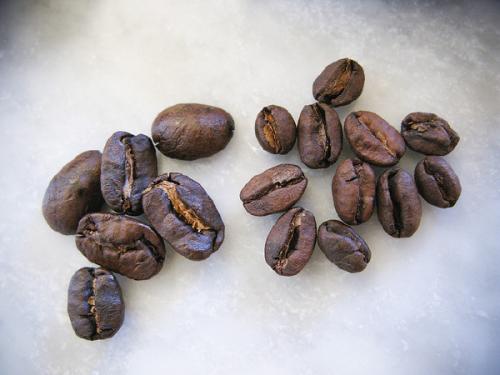Elephant bean Maragogype introduces how elephant beans bake Tibica mutant beans
For professional baristas, please follow the coffee workshop (Wechat official account cafe_style)
Elephant beans (Maragogype): beans are at least three times larger than the average Arabica, making it the largest in the world, hence the name. Elephant beans, the most well-known variety of Tibica beans, were first discovered in the Maragogype region of Bahia in northeastern Brazil in 1870. The high-quality bean industry is often called the birthplace of Malago Gibbs, commonly known as elephant beans. Mexico, Guatemala, Colombia and Dominica have a small amount of cultivation. Elephant beans are very suitable for the low altitude area of 700 to 800 meters, but the flavor is not distinctive, and even has a fishy smell. Elephant beans above 1000 meters above sea level have a slightly better flavor, soft sour taste and sweet fragrance.
Elephant beans are big, but they belong to soft beans. Most people have a bad impression of it, but in fact, the elephant beans at higher elevations have a special flavor and soft fragrance (due to the low fruit yield at high altitudes and the concentration of nutrients), but the production capacity is very low, which is not in line with economic benefits. in addition, the large fruit is not easy to wash or semi-washed, so coffee farmers are not willing to plant high-yielding Kaddura or Kaduai one after another. When baking elephant beans, due to the large and low density of the beans, it is appropriate to bake them over low heat if they are baked in a traditional semi-direct fire style; if they are roasted with hot air, they should be roasted in a small amount, lest the coffee beans cannot be blown by the hot air and the black focus can not appear.

Important Notice :
前街咖啡 FrontStreet Coffee has moved to new addredd:
FrontStreet Coffee Address: 315,Donghua East Road,GuangZhou
Tel:020 38364473
- Prev

Baking skills of European baker Jiang Chengze and Zhang Jinming
European roaster double roasting method: light roasted coffee with caramel lemon juice has the most attractive flowering acidity, but lacks the richness, smoothness and mellowness of medium or deep roasting, which is called body. Jiang Chengze and his partner Zhang Jinming discuss coffee aroma, balance and bean matching every day. One day, Zhang Jinming indulged in the aroma of cooking rice, blessed to the soul, thinking
- Next

The world's largest coffee beans.
Professional barista communication, please pay attention to coffee workshop (Weixin Official Accounts cafe_style) Maragogype: beans are at least three times larger than ordinary Arabica, which is the largest in the world, hence the name. The elephant bean is the best-known variety of Tibika bean, first discovered in 1870 in the Maragogype bean growing region of Bahia, northeastern Brazil. fine
Related
- Beginners will see the "Coffee pull flower" guide!
- What is the difference between ice blog purified milk and ordinary milk coffee?
- Why is the Philippines the largest producer of crops in Liberia?
- For coffee extraction, should the fine powder be retained?
- How does extracted espresso fill pressed powder? How much strength does it take to press the powder?
- How to make jasmine cold extract coffee? Is the jasmine + latte good?
- Will this little toy really make the coffee taste better? How does Lily Drip affect coffee extraction?
- Will the action of slapping the filter cup also affect coffee extraction?
- What's the difference between powder-to-water ratio and powder-to-liquid ratio?
- What is the Ethiopian local species? What does it have to do with Heirloom native species?

